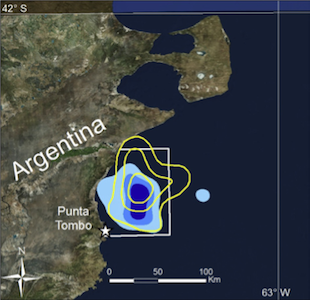
Marine protection is needed for Magellanic penguins in Argentina based on long-term data
P.Dee Boersma, Ginger A.Rebstock, Pablo García-Borboroglu
Biological Conservation 183:197-204. 2015.
Abstract
Magellanic penguins (Spheniscus magellanicus) are listed as near threatened by the IUCN. At their largest colony, Punta Tombo, Chubut, Argentina, active nests declined >30% over 30 years. Reproductive success is low, many penguins forage far from the colony, and starvation, the major cause of chick death, kills 39% of chicks on average each year. A 210-ha provincial reserve protects part of the breeding colony but there is no marine protected area (MPA) around Punta Tombo. An MPA protecting the foraging area of adults with small chicks could reduce chick starvation, increase reproductive success, and reduce adult mortality. The Province of Chubut wants an MPA to protect penguins at Punta Tombo but when and where would an MPA be most effective? We used our long-term dataset to determine that most chicks starve within 20–30 days after hatching (November and December). We used satellite tags to track penguins foraging for chicks <20 days of age in 1997–2001 and 2006–2009. Core foraging areas for penguins whose chicks did not starve (successful) and those whose chicks starved (unsuccessful) partially overlapped. Unsuccessful penguins, however, foraged farther from the colony (59 ± 27 km, N = 39 penguins, 115 trips) and had a larger core foraging area (554 km2) than successful penguins (46 ± 19 km, N = 23 penguins, 78 trips, P = 0.002; 375 km2). Unsuccessful parents took longer to return to feed their chicks, increasing chick starvation. There is a limited window of opportunity to secure protection through adequate management of a critical foraging area for penguins and the rich assemblage of other marine species using the same area. Increases in chick growth and survival would demonstrate the effectiveness of the MPA.